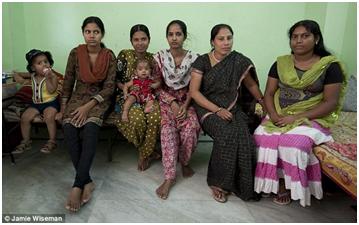Outsourcing pregnancy…

Money is obviously the common denominator in the surrogacy industry. And it is an industry, a global industry that connects the wealthy who have money with the poor who are willing to rent their wombs as a source of income.
Tagg Romney, son of Republican presidential hopeful Mitt Romney, recently put surrogacy in the headlines when he announced the birth of twin boys by “gestational surrogacy.” This means that he and his wife Jen are the genetic parents of the twins, who began life as embryos implanted in the womb of a surrogate. The Romney’s first three children were born to Jen Romney. Their fourth child was carried by the same surrogate as the twins.
In an article entitled “Money Changes Everything,” Jennifer Lahl, president of the Center for Bioethics and Culture, comments on the Romney story in the context of the global baby making industry:
The Romneys didn’t have to exploit a poor woman in India. They chose to exploit a woman, probably much less poor, right here in the U.S. And their surrogate might not have felt so exploited. She was just “helping a couple have a baby”—and being compensated for her help. Because of little regulation in the U.S., commercial surrogacy is legal and couples like the Romneys don’t have to outsource their pregnancies to India. Our Canadian neighbors got it right when the Supreme Court of Canada wrote, “allowing the purchase of human gametes and surrogacy services devalues human life and degrades those who choose to participate in such a commercial transaction” (emphasis mine).
It is poor women in India who are the focus of the second story Lahl references, this one from The Daily Mail: “The designer baby factory: Eggs from beautiful Eastern Europeans, sperm from wealthy Westerners and embryos implanted in desperate women.”
[The Wyzax Surrogacy Consultancy] boasts of being the country’s first ‘one-stop shop for outsourced pregnancy’. In truth, though, it is nothing less than a baby factory; the end of a grim production line on which children are being designed to order for wealthy couples, mainly from Western countries including Britain, as if they were custom-built cars.
For under an astonishing — and many will think nightmarishly futuristic — programme devised to make the most efficient use of resources, or ‘optimise’ their baby producing system, as they put it, Wyzax and their partner agencies now source and assemble the ‘components’ of some babies in a variety of different countries before flying the resulting embryo to India to be implanted in the surrogate.
For all their apparent desperation to start families, these so called ‘IPs’, or intended parents, have also become ever-more demanding in their specifications; many want babies who emanate from a gene pool which maximises the possibility that they will not only resemble them but have, say, blond hair and blue eyes (and hopefully be attractive, sporty and intelligent into the bargain).
Kohli and Singh have therefore devised a ‘protocol’ that works roughly like this: after careful screening for genetic illnesses and an IQ test, attractive young female egg donors from countries such as Ukraine, Lithuania, Georgia, Armenia and Belarus are advertised in an online catalogue for prospective parents to browse.
Labs in the U.S. are often part of the global equation since donor sperm is widely available here. Also, sex selection is available in the U.S. if prospective parents want to screen embryos in order to ensure that they get the desired sex, either a boy or a girl.
Once created, the embryos are frozen to minus 196c, placed in liquid nitrogen canisters resembling small milk-churns, then flown 8,000 miles from the U.S. to cities such as Delhi and Bombay, where they are implanted.
The Daily Mail rightly draws a parallel between the Indian surrogacy industry and automobile manufacturing. But the comparison ends at the “baby factory”—“the women who incubate and hatch these identikit children would be better compared to brood mares.” These women are coached on how to avoid becoming attached to the babies they carry, and some avoid even seeing the newborn in hopes that giving the baby up won’t “make them sad.”
Delivery is often by Caesarean section in order to minimize the risk of complications at the time of birth. This is the final step in the quality control process which began with the screening of embryos to ensure that only the desirable ones are implanted. Now, the goal is to make sure that the finished product is not damage during delivery.
With its commercial and manufacturing components, the baby business turns child bearing on its head—these babies are “made rather than begotten.”


 July 30, 2012
July 30, 2012 








Comments are closed.